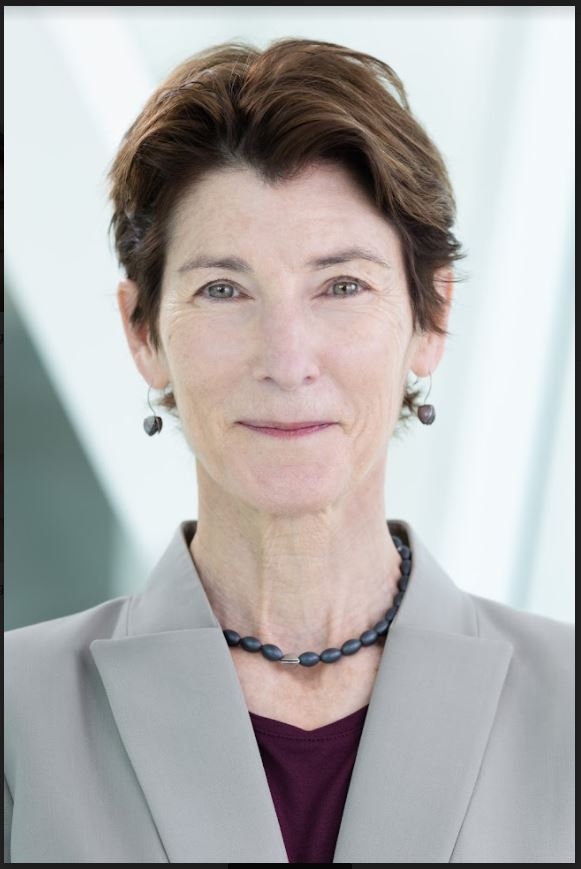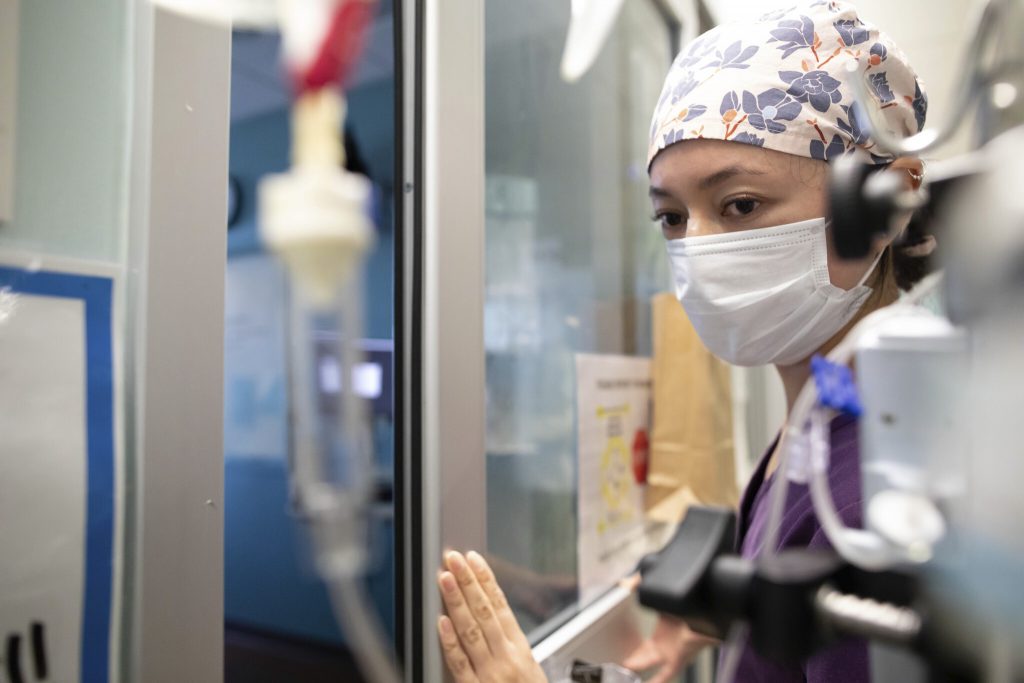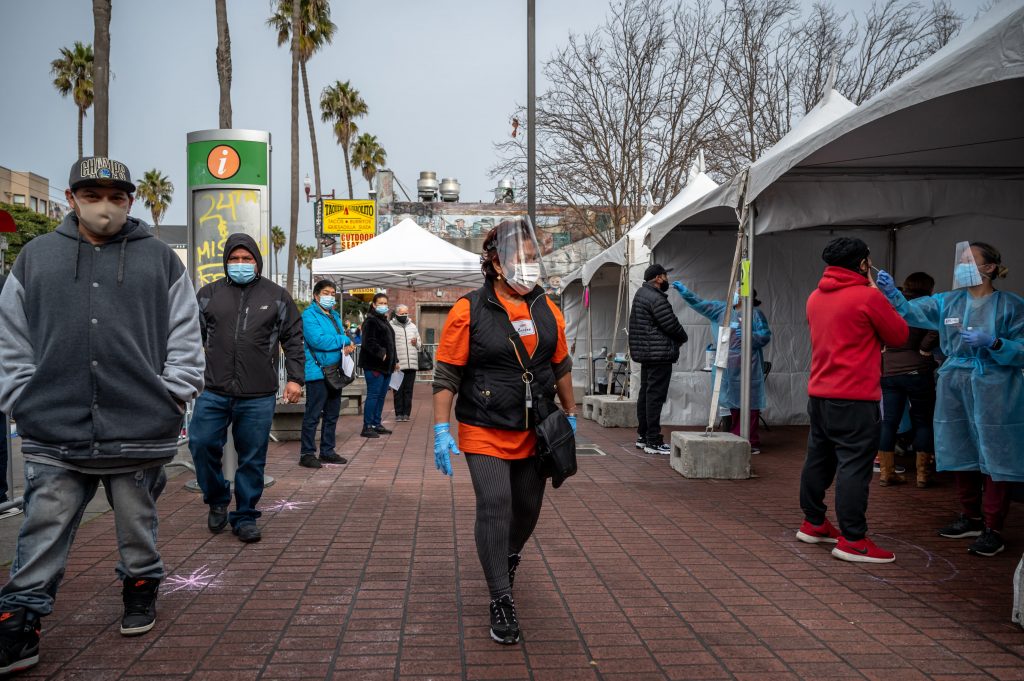Article by: Aisling Carroll
When Dr. Susan Ehrlich took over as CEO at Zuckerberg San Francisco General Hospital (ZSFG) in 2016 after leading San Mateo Medical Center, her life and career had already “touched on this hospital in a number of different ways going back to the 80s,” she said.

Before completing medical school at UCSF, Ehrlich worked at the San Francisco Department of Public Health during the AIDS epidemic. A department she would closely strategize and collaborate with years later when COVID-19 hit San Francisco.
“You have to be humble with this pandemic because every day is a new day. You can never assume you’ve got it down,” she said in the wake of the fourth COVID-19 surge, epitomizing her hyper-observant nature. Although the number of patients hospitalized hasn’t been as high at ZSFG as in other parts of the state, the hospital has been stressed caring for the city’s most at-risk residents.
Yet for the last year and a half, Ehrlich and her team have set out to get ahead of the pandemic. They’ve focused on following the COVID-19 data while listening and learning from the hospital’s mostly low-income patients about their wide-ranging needs. Ehrlich mentions their need for housing and food as much as medical care.
For the nurses, physicians and the other 5,000+ staff who have flexed to care for ZSFG’s patients at every COVID turn, Ehrlich says they’ve been “masterful.” But they’re also exhausted. Below Ehrlich discusses how she and her team support the staff at ZSFG, which is in part through extensive communication and continuing to prioritize other mission-oriented efforts, including reducing the health care disparities that staff care about.
This interview was condensed and edited for clarity.
Can you tell me about your role in overseeing San Francisco’s response to COVID-19?
Well, it was quite a response. The most important feature of what’s happened in San Francisco is that from the very first moment, the entire response has been based on science, data and facts. The public health emergency was declared before there was even a COVID case diagnosed in the city because the city’s health leaders had been studying what was going on in other parts of the world and knew it was something serious. And we were also one of the first places in March 2020 to issue a shelter-in-place order.
I think the leaders here, including the mayor, the board, the public health director, the hospital leaders, everyone in health care was really focused on doing the right thing for the community, and that’s had a profound impact on how the pandemic has shown itself in San Francisco.
“San Francisco has one of the highest vaccination rates in the world.”
This was a very coordinated response. One really good example of that is the way the city set up mass vaccination sites in conjunction with all of the major health systems. We had the fourth mass vax site here at ZSFG, vaccinating 2,000 people a day at the height of our efforts. And that doesn’t even begin to describe the efforts that were going on in the community. A key part of the effort now is to hone in on the areas of the community that have the lowest vaccination rates and, sadly, the highest infection rates.
The other important thing that informed the city’s response was its history and legacy with the AIDS epidemic. We were also a leader early on in that epidemic and followed science, data and facts in our community-based response then. And interestingly, our city’s health director, Dr. Grant Colfax, and our chief of the HIV, Infectious Diseases and Global Medicine Division here at ZSFG, Dr. Diane Havlir, had direct experience with leading during those times. So there was a lot of learning that they did at that time that has direct relevance for our response today.
What has been the impact of these approaches?
We’re part of a big community effort, and we’ve already seen the impact of that. San Francisco has one of the highest vaccination rates in the world. Just last week, as a community, we surpassed 80 percent of the eligible population having completed vaccination in San Francisco. Eighty percent. That compares to 52 percent in the United States. And even before vaccinations became available, we knew that we had the lowest death rate from COVID of any major urban area in the United States.
So we have very hard evidence to show what our efforts have done. And we’ve been a big part of that. We’ve been vaccinating people here, we’ve been caring for anywhere between 20 and 30 percent of the COVID-infected individuals in the city.
I’m so grateful to the team here and all they’ve been able to accomplish during this past year and a half. It’s truly remarkable.

Do you have an example of your community-based responses to COVID-19 at Zuckerberg San Francisco General Hospital?
Very early on in this pandemic, we noticed that almost every person we admitted to this hospital was Hispanic/Latino/Latina, and they make up about 15 percent of the San Francisco population, so that was a startling thing. It was the beginning of really understanding how this pandemic was going to shine a bright light on pre-existing health care disparities and social disparities.
In response to what we were seeing, Dr. Havlir and leaders in her division developed the Unidos en Salud program, which is a community partnership with the Latino Task Force. Initially, their team went into the community to do testing for folks in the Mission that was accessible to them, but also to learn about the disease to respond better in the future and to offer services and to listen to the community about what they needed.
So if somebody was diagnosed with COVID through the testing program, they could offer food. They could offer an isolation and quarantine site. They could offer income support that the city provided. And that effort continued and now there’s a vaccination site and a testing site still in the Mission, and we work very closely with the Latino Task Force.
I’m not saying that’s been a smooth thing all along, it’s been bumpy. But our experience with this pandemic has really driven home how important that connection with the community and listening to the community and taking the lead from the community about what’s needed is.

As a physician, you see patients for half a day a week. What’s it like to be a doctor during the pandemic?
I consider this an essential part of my job that I love and cherish very much. During COVID, it’s been a really interesting window into what’s happening, and it’s driven home issues of health care disparities and economic disparities because of the way this pandemic has impacted the patients we take care of so dramatically.
My patients have lost their jobs. They’ve had really tough living situations. They have become infected with COVID. They’ve struggled with depression and substance use problems. We do everything we can to help and support them through those things. We have folks who have gone to deliver food to people, and we have provided as many services as we can.
A lot of hospitals are grappling with staff shortages, especially nurses. How are you trying to retain people?
This is a key question for everybody in health care right now because people are exhausted. It’s not the same now as it was at the beginning. Then we were all shocked and dismayed and everybody jumped in. We’re still doing that, but it’s a year and a half later, and people are tired.
So how do you continue to provide the health care that people need for COVID and everything else and keep your staff motivated and joyful and happy about coming to work every day? It’s a huge challenge.
“We’ve provided a lot of mental health resources.”
What do we do here? We do a lot more communicating now than we did before. We send out a daily newsletter because there are so many things that change all the time. It’s also a venue for shout-outs so we have an easy way for people to recognize other people. And every Monday morning, I write a letter, like a small essay, to the community reflecting on what’s happening and recognizing people and programs.
We do a lot of listening to what staff need. We’ve done a lot of staff appreciation events. We’ve provided a lot of mental health resources. The different behavioral health programs that we have are because our staff have come to us. So, for example, chaplains going to huddles and the Department of Psychiatry providing support for folks because they had heard from people that would be useful.
And then asking people, “How are you doing? And how are we doing meeting your needs?”

Of those approaches, have any surprised you in terms of how they’ve resonated with staff?
I’ll say not surprising so much but validating is how much our staff want information and how much our different ways of communicating with them have been helpful.
A long time ago in my career, I heard a leader talk about what percentage of time a leader needs to spend communicating. He used a figure like 30 or 40 percent. I thought that’s got to be wrong, that can’t be right, but I actually think it’s true. The more we communicate with our folks, the more we provide opportunities for them to give us feedback, the better people feel about being engaged in what they’re doing and like they have control over their environment, especially at a time like this.
What strategic goals were underway pre-pandemic at ZSFG, and how have they evolved since?
One really important example of the way the pandemic has reinforced the importance of our strategic goals relates to the issue of equity. We’ve been working on becoming an equitable organization since 2016, in terms of both eliminating health care disparities among our patients and also addressing inequities in the makeup of our workforce.
We’re making really good progress in a variety of different ways. When the pandemic hit and then when George Floyd was tragically murdered, it just lit a fire under all of our efforts. As a result, we’ve been able to double down on our efforts related to equity.
So what I mean by that is that about 60 percent of our clinical and operational departments in the hospital have identified a health care disparity that’s important in their area, and they are working actively to improve it. A lot of the things we’re working on aren’t necessarily pandemic related.
“Our equity efforts are another area where people are really motivated.”
Can you give me an example?
One of our big issues is readmissions to the hospital for heart failure. Black African Americans, especially men, are way overrepresented in that group. We have a really wonderful partnership between our cardiologists and our primary care providers to develop ways of reducing those disparities. We have a lot of work going on in this area, and it has been successful.
How are you able to do this work given the pandemic?
One of the things that keeps people joyful at work is knowing that they’re working together on a mission. They’re doing critically important work in terms of serving the community and serving our patients. Our equity efforts are another area where people are really motivated.
Knowing there can be future COVID-19 variants, how do you see ZSFG continuing to push forward? And where would you like to see the system a year from now?
In addition to responding to the pandemic, we have our strategic direction, our True North. It’s all about equity, safety, quality, patient experience, staff experience and financial stewardship. Our goal is to meet all of those metrics.
This blog is part of a series funded by the California Health Care Foundation.